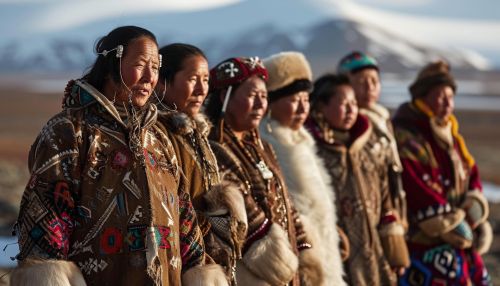Inuit
Origins and Ancestry
The Inuit are a group of culturally similar indigenous peoples inhabiting the Arctic regions of Greenland, Canada, and Alaska. The term Inuit, meaning "the people" in the Inuktitut language, is often used to refer to all Inuit-related groups, including the Inupiat of Alaska and the Kalaallit of Greenland.


The origins of the Inuit are traced back to the Thule culture, which emerged in Alaska around 1000 CE and spread eastward across the Arctic. The Thule people were highly skilled hunters and gatherers, with a deep understanding of their harsh environment. They developed sophisticated tools and technologies, such as the kayak and the umiak, to adapt to the challenging Arctic conditions.
Culture and Traditions
Inuit culture is deeply rooted in the Arctic environment. The Inuit have developed a rich oral tradition, with stories, myths, and legends passed down from generation to generation. These narratives often feature animals and natural phenomena, reflecting the Inuit's close relationship with the natural world.
The Inuit also have a strong tradition of visual arts, particularly carving and printmaking. Inuit artists often use materials readily available in the Arctic, such as bone, ivory, and stone, to create intricate sculptures and carvings. These works often depict animals, human figures, and scenes from Inuit mythology.
Language and Communication
The Inuit speak a variety of dialects of the Inuktitut language, which belongs to the Eskimo-Aleut language family. Inuktitut is written using a unique syllabic script, which was developed in the 19th century by European missionaries. Despite the influence of English and French, especially in Canada, many Inuit continue to speak Inuktitut as their first language.
Social Structure and Governance
Traditionally, the Inuit lived in small, nomadic groups, with leadership typically held by the most experienced hunters or elders. Decision-making was often a communal process, with all adult members of the group having a voice.
Today, the Inuit have a variety of governance structures, ranging from local community councils to regional and national organizations. In Canada, the Inuit Tapiriit Kanatami (ITK) serves as the national voice of the Inuit, advocating for the rights and interests of Inuit communities across the country.
Contemporary Issues
The Inuit face a number of contemporary challenges, including climate change, economic development, and cultural preservation. The rapid warming of the Arctic is particularly concerning, as it threatens the Inuit's traditional hunting and fishing practices.
Efforts are underway to address these issues, with a focus on sustainable development, cultural revitalization, and self-determination. The Inuit are increasingly involved in decision-making processes at all levels, from local community planning to international climate negotiations.
